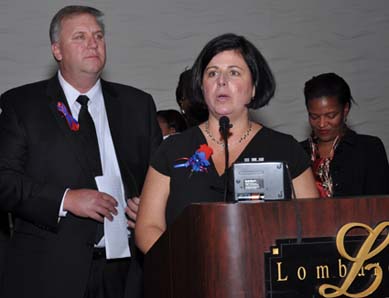January 12, 2012
 Inspired by daughter's love for Haiti: Leonard and Cherylann Gengel accepted an award last Saturday from Haitian-Americans United for their dedication to the people of Haiti. Their daughter Britney was killed in the earthquake.Today marks the two-year anniversary of the catastrophic earthquake that destroyed much of Haiti’s capital city, Port-au-Prince. The death toll from that awful day is still in dispute, but even conservative estimates are mind-blowing, in the hundreds of thousands.
Inspired by daughter's love for Haiti: Leonard and Cherylann Gengel accepted an award last Saturday from Haitian-Americans United for their dedication to the people of Haiti. Their daughter Britney was killed in the earthquake.Today marks the two-year anniversary of the catastrophic earthquake that destroyed much of Haiti’s capital city, Port-au-Prince. The death toll from that awful day is still in dispute, but even conservative estimates are mind-blowing, in the hundreds of thousands.
Americans responded to our neighbors’ distress in impressive ways. According to the American Red Cross, they received an astounding $486 million in donations here in the States for Haiti relief. A full 60 percent of American households contributed to the aid drive.
In Boston, doctors and nurses flew to the rescue by the plane-load. Our hospitals and health centers — where Haitian professionals are so well represented in day-to-day life— were essential to the on-the-ground response. And, of course, American troops played an important role in the first weeks after the quake, providing rescue and support services across the stricken nation.
Many have never stopped going back or helping out from here. This week, for example, Carney Hospital president Bill Walczak is in Haiti, surveying efforts to rebuild the country’s health infrastructure. As we report on our front page this week, Codman Square Health Center continues to serve the victims of the earthquake and their families with a unique support group aimed at mental health needs triggered by the earthquake.
Given the deep ties between the two cities, and the large Haitian-American community here, it’s fitting that we turn our attention southward to note that there has been significant, if insufficient, progress made in helping those most affected by Jan. 12, 2010.
Here are a few facts:
• According to a just-released report from the Red Cross, over 600,000 people displaced by the earthquake are still living in “camps” recognized by the United Nations.
• The cholera epidemic that began last year has now claimed over 7,000 lives and has infected over 150,000 people.
• The Haitian government and international observers say 600 classrooms for 60,000 children have been opened and more than half of the 10 million cubic meters of rubble cleared.
On the bright side, two projects with key Boston connections are making significant progress right now: A new, state-of-the-art teaching hospital is rising in a town called Mirebalais. The hospital, at 180,000 square feet, will be the country’s largest health care facility and is scheduled to open later this year. The 320 bed facility will be run by Partners in Health, the Boston-based organization led by Dr. Paul Farmer. Many Bostonians have gone to Haiti to help build the facility, led by local businessman Jim Ansara. More on that can be found online at pih.org.
And, a smaller but equally inspiring building is also going up on top of a hill outside Port-au-Prince. The Gengel family of Rutland, MA is leading the effort to build a new orphanage on the site to memorialize their 19 year-old daughter and sister, Britney, who died in the earthquake while on a humanitarian mission. Last weekend, Boston’s Haitian community honored the Gengel family at the annual Haitian Independence Day Gala in Randolph.
Sen. Kerry, also honored at the event, said in a statement of the Gengels: “It is hard to imagine the strength and compassion that Len and Cherylann found inside themselves not just to carry on after losing Britney, but to keep alive her passion and her idealism by helping the Haitian people for the long haul. The orphanage in Grand Goave isn’t just a home for Haitian children to grow and thrive, it is life itself, and there’s no better way imaginable to keep alive Britney’s spirit, compassion and dedication to service.”
The new orphanage will open next year. More about the project can be read online at belikebrit.org
-Bill Forry


